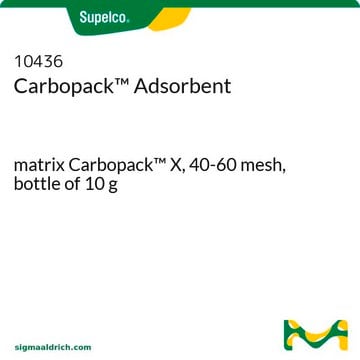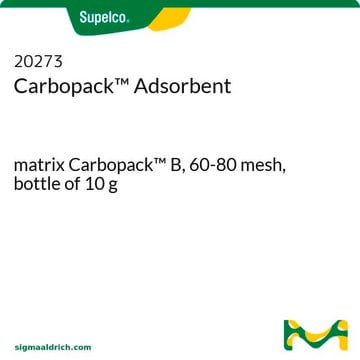11051-U
Carbopack™ Adsorbent
matrix Carbopack™ Z, 60-80 mesh, bottle of 10 g
About This Item
Recommended Products
product line
Carbopack™
form
granular
packaging
bottle of 10 g
technique(s)
LPLC: suitable
gas chromatography (GC): suitable
solid phase extraction (SPE): suitable
surface area
~220 m2/g
matrix
Carbopack™ Z
matrix active group
carbon
particle size
60-80 mesh
pore size
~0 cm3/g macroporosity
~0 cm3/g microporosity
~1.73 cm3/g mesoporosity
~255 Å pore diameter
density
~0.16 g/mL (free fall density)
separation technique
reversed phase
Looking for similar products? Visit Product Comparison Guide
General description
- Granular
- Friable
- Used for molecules with an analyte size relative to C3-C20+ n-alkanes
- Hydrophobic (can be used in high humidity environments)
Generally, GCB adsorbents offer weaker relative adsorptive strength compared to carbon molecular sieve (CMS) adsorbents, and similar relative adsorptive strength compared to spherical graphitized polymer carbon (SGPC) adsorbents. Our Carbopack products are a type of GCB adsorbent.
- Particles are 40 mesh and smaller
- Use 40/60 mesh to prevent channeling (if observed with a 20/40 mesh Carbotrap® adsorbent)
- Use smaller mesh (60/80, 80/100, etc.) for all other applications
- Use the smallest particle size available as long as the application can handle the pressure drop
For more information about any of our specialty carbon adsorbents, please visit sigma-aldrich.com/carbon
Legal Information
Storage Class Code
11 - Combustible Solids
WGK
nwg
Flash Point(F)
Not applicable
Flash Point(C)
Not applicable
Personal Protective Equipment
Choose from one of the most recent versions:
Certificates of Analysis (COA)
Sorry, we don't have COAs for this product available online at this time.
If you need assistance, please contact Customer Support.
Already Own This Product?
Find documentation for the products that you have recently purchased in the Document Library.
Customers Also Viewed
Articles
Synthetic CMS carbons offer tailored adsorbents for specific applications.
Synthetic CMS carbons offer tailored adsorbents for specific applications.
Synthetic CMS carbons offer tailored adsorbents for specific applications.
Synthetic CMS carbons offer tailored adsorbents for specific applications.
Our team of scientists has experience in all areas of research including Life Science, Material Science, Chemical Synthesis, Chromatography, Analytical and many others.
Contact Technical Service






